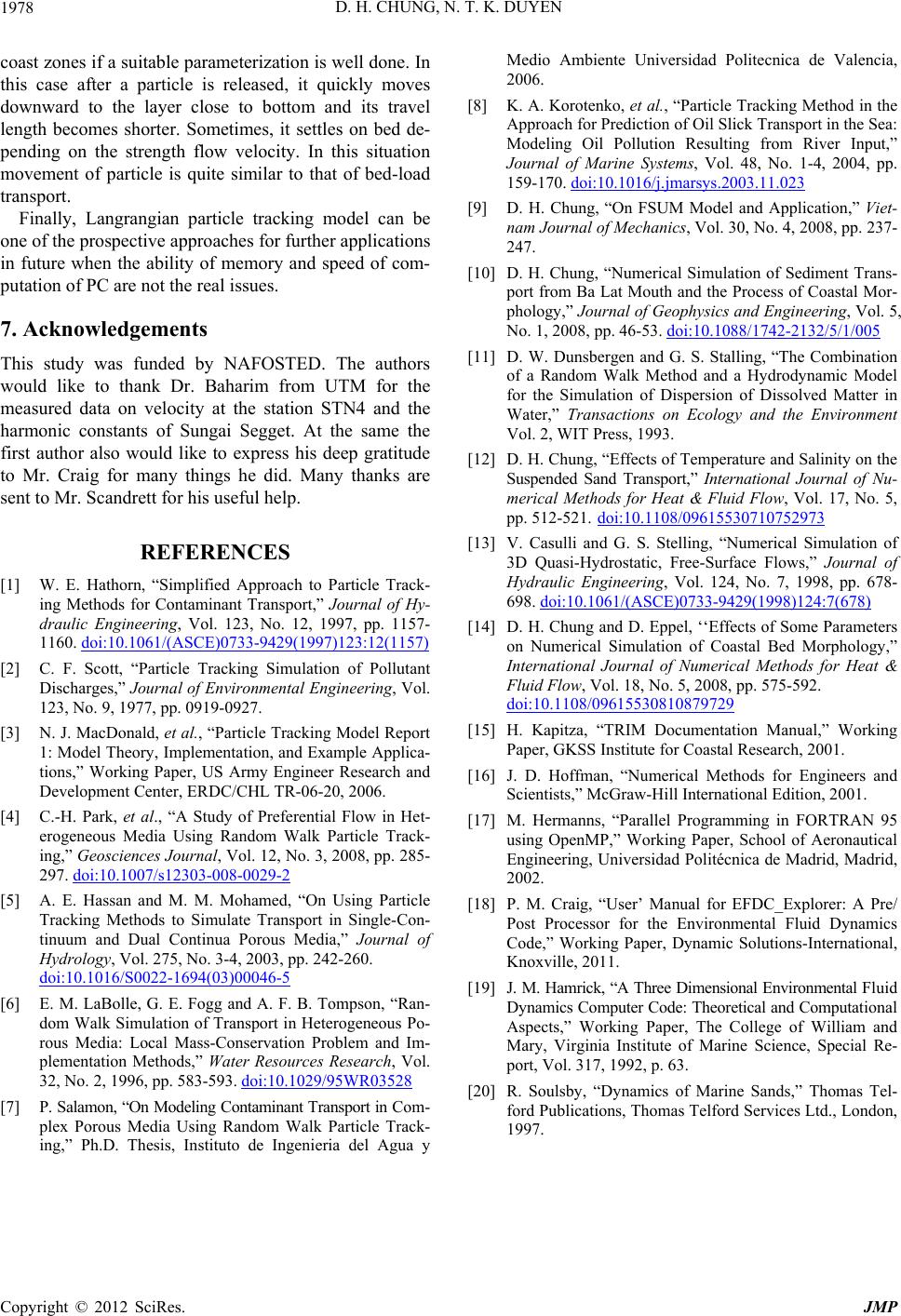
D. H. CHUNG, N. T. K. DUYEN
Copyright © 2012 SciRes. JMP
1978
coast zones if a suitable parameterization is well done. In
this case after a particle is released, it quickly moves
downward to the layer close to bottom and its travel
length becomes shorter. Sometimes, it settles on bed de-
pending on the strength flow velocity. In this situation
movement of particle is quite similar to that of bed-load
transport.
Finally, Langrangian particle tracking model can be
one of the prospective approaches for further applications
in future when the ability of memory and speed of com-
putation of PC are not the real issues.
7. Acknowledgements
This study was funded by NAFOSTED. The authors
would like to thank Dr. Baharim from UTM for the
measured data on velocity at the station STN4 and the
harmonic constants of Sungai Segget. At the same the
first author also would like to express his deep gratitude
to Mr. Craig for many things he did. Many thanks are
sent to Mr. Scandrett for his useful help.
REFERENCES
[1] W. E. Hathorn, “Simplified Approach to Particle Track-
ing Methods for Contaminant Transport,” Journal of Hy-
draulic Engineering, Vol. 123, No. 12, 1997, pp. 1157-
1160. doi:10.1061/(ASCE)0733-9429(1997)123:12(1157)
[2] C. F. Scott, “Particle Tracking Simulation of Pollutant
Discharges,” Journal of Environmental Engineering, Vol.
123, No. 9, 1977, pp. 0919-0927.
[3] N. J. MacDonald, et al., “Particle Tracking Model Report
1: Model Theory, Implementation, and Example Applica-
tions,” Working Paper, US Army Engineer Research and
Development Center, ERDC/CHL TR-06-20, 2006.
[4] C.-H. Park, et al., “A Study of Preferential Flow in Het-
erogeneous Media Using Random Walk Particle Track-
ing,” Geosciences Journal, Vol. 12, No. 3, 2008, pp. 285-
297. doi:10.1007/s12303-008-0029-2
[5] A. E. Hassan and M. M. Mohamed, “On Using Particle
Tracking Methods to Simulate Transport in Single-Con-
tinuum and Dual Continua Porous Media,” Journal of
Hydrology, Vol. 275, No. 3-4, 2003, pp. 242-260.
doi:10.1016/S0022-1694(03)00046-5
[6] E. M. LaBolle, G. E. Fogg and A. F. B. Tompson, “Ran-
dom Walk Simulation of Transport in Heterogeneous Po-
rous Media: Local Mass-Conservation Problem and Im-
plementation Methods,” Water Resources Research, Vol.
32, No. 2, 1996, pp. 583-593. doi:10.1029/95WR03528
[7] P. Salamon, “On Modeling Contaminant Transport in Com-
plex Porous Media Using Random Walk Particle Track-
ing,” Ph.D. Thesis, Instituto de Ingenieria del Agua y
Medio Ambiente Universidad Politecnica de Valencia,
2006.
[8] K. A. Korotenko, et al., “Particle Tracking Method in the
Approach for Prediction of Oil Slick Transport in the Sea:
Modeling Oil Pollution Resulting from River Input,”
Journal of Marine Systems, Vol. 48, No. 1-4, 2004, pp.
159-170. doi:10.1016/j.jmarsys.2003.11.023
[9] D. H. Chung, “On FSUM Model and Application,” Viet -
nam Journal of Mechanics, Vol. 30, No. 4, 2008, pp. 237-
247.
[10] D. H. Chung, “Numerical Simulation of Sediment Trans-
port from Ba Lat Mouth and the Process of Coastal Mor-
phology,” Journal of Geophysics and Engineering, Vol. 5,
No. 1, 2008, pp. 46-53. doi:10.1088/1742-2132/5/1/005
[11] D. W. Dunsbergen and G. S. Stalling, “The Combination
of a Random Walk Method and a Hydrodynamic Model
for the Simulation of Dispersion of Dissolved Matter in
Water,” Transactions on Ecology and the Environment
Vol. 2, WIT Press, 1993.
[12] D. H. Chung, “Effects of Temperature and Salinity on the
Suspended Sand Transport,” International Journal of Nu-
merical Methods for Heat & Fluid Flow, Vol. 17, No. 5,
pp. 512-521. doi:10.1108/09615530710752973
[13] V. Casulli and G. S. Stelling, “Numerical Simulation of
3D Quasi-Hydrostatic, Free-Surface Flows,” Journal of
Hydraulic Engineering, Vol. 124, No. 7, 1998, pp. 678-
698. doi:10.1061/(ASCE)0733-9429(1998)124:7(678)
[14] D. H. Chung and D. Eppel, ‘‘Effects of Some Parameters
on Numerical Simulation of Coastal Bed Morphology,”
International Journal of Numerical Methods for Heat &
Fluid Flow, Vol. 18, No. 5, 2008, pp. 575-592.
doi:10.1108/09615530810879729
[15] H. Kapitza, “TRIM Documentation Manual,” Working
Paper, GKSS Institute for Coastal Research, 2001.
[16] J. D. Hoffman, “Numerical Methods for Engineers and
Scientists,” McGraw-Hill International Edition, 2001.
[17] M. Hermanns, “Parallel Programming in FORTRAN 95
using OpenMP,” Working Paper, School of Aeronautical
Engineering, Universidad Politécnica de Madrid, Madrid,
2002.
[18] P. M. Craig, “User’ Manual for EFDC_Explorer: A Pre/
Post Processor for the Environmental Fluid Dynamics
Code,” Working Paper, Dynamic Solutions-International,
Knoxville, 2011.
[19] J. M. Hamrick, “A Three Dimensional Environmental Fluid
Dynamics Computer Code: Theoretical and Computational
Aspects,” Working Paper, The College of William and
Mary, Virginia Institute of Marine Science, Special Re-
port, Vol. 317, 1992, p. 63.
[20] R. Soulsby, “Dynamics of Marine Sands,” Thomas Tel-
ford Publications, Thomas Telford Services Ltd., London,
1997.